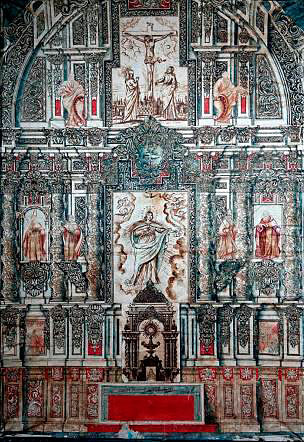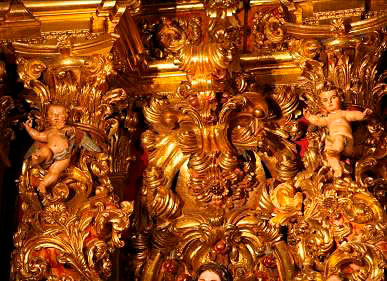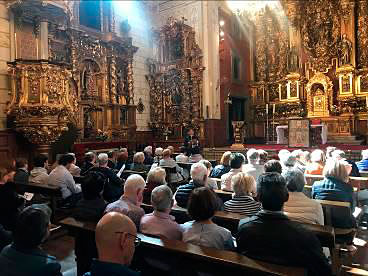22 May
Global Seminars & Invited Speaker Series
THE WORK IN ITS CONTEXT
The Recoletas altarpieces in Pamplona
Ricardo Fernández Gracia
Chair of Navarrese Heritage and Art
The foundation of the Augustinian Recollect Nuns in the capital of Navarre dates back to 1634 and its building is the finest example of convent architecture in Navarre, according to the canons of the 17th century. Its founder was Don Juan de Ciriza, Marquis of Montejaso and secretary to King Philip III. The plans for its construction were drawn up by the royal master builder Juan Gómez de Mora. The inauguration of the complex is reflected in this concise but illustrative text, dated 4th June 1634: "On the day of Pentecost the church was adorned with very solemn apparatus, the viceroy attended mass with all the cavalry, the city of Pamplona in form, the marquis who founded and who endowed the convent with such a long hand, first patron saint, maker, founder and endower".
The first main altarpiece, of subjectclassicist style, was made between 1631-1633 by Domingo de Bidarte and his son-in-law Domingo de Lusa, and was intended to contain the large altar canvas of the Immaculate Conception, painted by Vicente Carducho in 1632. If we take into account the tastes of the Marquis and his son the archdeacon of the Chamber of the cathedral of Pamplona, who was in charge of the convent's works, we must assume that it would have been in keeping with the altarpieces of the Barbazana in Pamplona cathedral, in whose execution the archdeacon collaborated as patron. Around 1680, the nuns must have thought of another more fashionable and sumptuous piece, as can be seen in an enormous coloured designdesigned by the Guipuzcoan architect Juan de Ursularre, who had settled in Madrid.

designby Juan de Ursularre for the main altarpiece of Recoletas, c. 1680.
The set by Francisco Gurrea with polychromy by Francisco de Aguirre (1700-1713)
Whether because Ursularre died or due to other circumstances, the projectremained on paper, and it was not until 1700 that the contract was signed with the Tudela master Francisco Gurrea (1653-1709) to carry out the work, following his own design. The set of altarpieces was the last great work of the artist from Tudela, A, the best official of the Kingdom, as was proclaimed by then, in words and in writing, by numerous testimonies. Before its completion, the very chapter of Pamplona cathedral had entrusted him with the altarpieces of the ambulatory of the cathedral, although he was unable to complete them because of his death. Gurrea's arrival in Pamplona to undertake the Recoletas commission in 1700 took place in the middle of the construction of the chapel of San Fermín and at a time when many of its churches and the cathedral itself were being dressed with new altarpieces.
Francisco Gurrea (1653-1709) was undoubtedly one of the most important figures in the Tudela workshop between the 17th and 18th centuries; son and grandson of altarpiece makers and brother-in-law of another great master, Sebastián de Sola y Calahorra, with whom he would complete his career training, after being orphaned at the age of fourteen. He worked with the latter until 1687 on the altarpieces of the Rosario de Corella (1670-1680), Milagro (1679-1684) and Franciscanos de Tafalla (1682). From his workshop and as personal projects came the major altarpieces of the Dominicas de Tudela (1689), Murchante (1696-1797), Caparroso (1691), San Miguel de Tudela -today in Monteagudo- (1697-1699), Falces (1700-1703), San Blas de Peralta (1694) and the Recoletas complex (1700-1708). He supplied traces and designs for other singular works and directed the comparsa de gigantes of the capital of La Ribera.

Main altarpiece of the Augustinian Recollect Nuns of Pamplona, by Francisco Gurrea, 1700-1708.
Among the chapters of the contract with the Augustinian Recollect Nuns of Pamplona, we will highlight some of them. The one referring to the material indicates that the pine that was to be used was that which came down the Aragon river from the Pyrenean mountains. As for the proportions, it was stated that it would occupy the full dimensions of the entire front wall of the chancel of the church. With regard to the formal characteristics, constant reference is made to the signed outline of the parts, at the same time as the parts of the altarpiece are detailed with great precision. accredited specializationSpecial mention is made of the averagecane which Gurrea had already used in the main altarpieces of Caparroso and Falces, and his uncle Sebastián de Sola in the altarpiece of San Cosme and San Damián in Arnedo. Particular attention is paid to the ornamentation, describing the carved ornaments and mouldings, as well as the seraphim on the pedestals of the bench and the graceful ornaments on the arches. As was usually the case, the document includes some modifications to the layout, such as the issueof the children on the columns, which would be enlarged for greater ornamentation and magnificence. The price of the work amounted to 2,000 ducats payable in several instalments, 500 when the deed was signed and the rest in three instalments, as the work progressed, ten months at a time.
The iconographic indications in the contract include the nuns' intention to reuse part of the reliefs from the previous altarpiece by Domingo de Bidarte. However, Gurrea's own observations led to his partnerin the major projects, Juan de Peralta, taking over positionfor the most substantial part of the altarpiece, and on 22 September 1708 the Recollect nuns contracted the aforementioned master to execute the Immaculate Conception to preside over the altarpiece, presenting as modelthe exquisite image carved by Manuel Pereira (1649). procedureYears later, the aforementioned Juan de Peralta received other commissions for the set of altarpieces, datawhich we know from simple receipts that were not notarised, which gives us an idea of how the sculptors of the works of his specialization program, often without going through the notary, position, which we have been able to verify at other times. In 1712 Peralta signed a receiptfor the sculpture of Saint Anthony, some children and the doors of the tabernacles of the side altarpieces.
The submissionof the altarpieces was made in November 1708, stating that the last payment for the work carried out by Gurrea had amounted to 3,000 ducats, of which the master had already received 2,500. The aforementioned amount makes it one of the most expensive complexes in Navarre at that time, although it is close to what he had received in Caparroso or Falces. A few years later, in 1713, a gilder established in Tudela, Francisco de Aguirre, took on positionfor the polychromy and gilding of the three altarpieces, which gave them their finalappearance and sumptuousness. The document is very rich in all subjectof details. Thus, for the bowl it indicates that the Llanes and Arnedillo colours were to be mixed, and for the backgrounds a blue imitating lapis lazuli was envisaged, something that was replaced by the current reds, either at that time or later.
The altarpiece consists of a sotabanco, averagecane, a high bench, a single body divided into three sections by giant Solomonic columns and a semicircular attic. Its broken floor plan with interesting movements and recessed side streets presents an altarpiece subjectwith broad echoes of different regional workshops. A noteworthy element in the city of Pamplona is the averagereed, highly decorated with foliage and large scallops, which was already used by Gurrea in the main altarpieces of Caparroso and Falces, and also by other masters such as José de San Juan in Azagra and Cárcar, Sebastián de Sola and José Tobar in Arnedo, and Juan Baines in the main altarpiece of Garde. Professor Martín González compares this averagereed or base of foliage, due to its effectiveness, with a "kind of jardinière that nourishes the whole altarpiece with plants". The high bench is made up of six large netos with pinjantes of fruit, the two central ones corresponding to the main street of the altarpiece are placed in front of those on the sides.
The baroque style, typical of that decorative or traditional stage of the Baroque, is intensified in the noble body, divided into three streets, the central one enhanced by its greater width, its advancement with respect to the lateral ones and its crowning. The lateral ones use salomonic columns richly dressed with foliage and round children who sit in the breasts of the salomonic columns. In the central street the columns disappear and in their place we only see the traspilastras with corbels with their corresponding capitals, which link with the line of the architrave, in their place we see a pair of statues, authentic supports of the Augustinian order, Saint Augustine and Saint Monica. This resourcecan be found immediately afterwards in some altarpieces by the master Juan Angel Nagusia from Estella, such as the main altarpiece in the basilica of Mendigaña or that of San Francisco Javier in Los Arcos.
In the enclosure of the piece, the salomonic elements that frame the centre of the attic and the splendid finial with a large cartouche and crown stand out. The decoration, once again, shows us samplea Gurrea capable of creating very delicate plant-inspired ornaments with scrolls, foliage, fruit, cards, without neglecting the powerful and lively architecture.

Detail of the main altarpiece of the Augustinian Recollect Sisters of Pamplona, by Francisco Gurrea, 1700-1708.
On the bench are two reliefs of the Assumption and the Birth of the Virgin, which, according to the contract, were chosen by the nuns. The sculptures of Saint John and Saint Catherine were placed in the intercolumniations of the side streets, instead of the Saint John and Saint Joseph that had been planned; the nuns' homage and remembrance of the patron saints of the convent's founders, Don Juan de Ciriza and Doña Catalina de Alvarado, took precedence. For the main figure, contracted with Juan de Peralta in 1708, as we have already noted, the Madrid artist modelde Pereira was chosen. At the sides, replacing the columns themselves, we find the authentic supports of the Augustinian order, St. Augustine and St. Monica. In the attic is the Calvary, as usual, and above the entablatures, plumb with the extreme columns, the figures of St. Francis and St. Clare. Their presence is explained by the memory of the founders, since, before bringing the Augustinian nuns, they had thought of the Franciscan nuns, due to the special devotion they had to that order and its holy founders.
Comparing Gurrea's altarpiece with the unrealised projectby Juan de Ursularre y Echeverría, we can see that the general outlinewith three lanes, the use of salomónicas, the curved top and the central lane are the same in both cases. However, there are also differences. In the work by the Tudela-born artist, there is no space for canvases, and the bower of the salomónicas and the machones of the attic have disappeared. The iconography has been reduced in the executed work and the foliage subjectis very different and a little more progressive.
For the collaterals of Saint Joseph and Saint Anthony, the martyrdom of Saint Lawrence was chosen as a complement in their attics as a sign of the convent's belonging to the parish of Saint Lawrence and the Flight into Egypt in the case of Saint Joseph, at a time when devotion to the Banishment was spreading among various religious orders.

The altarpiece of the Virgin of Wonders
The altarpiece of the Virgen de las Maravillas dates from 1674 and follows the models of the early Solomonic Baroque with a high bench that has been greatly altered, a single body with three aisles articulated by torsa columns decorated with grapes and an attic with the same subjectas a support. Its patron was Don Juan Antonio Berasategui, canon of Murcia Cathedral. The chronicle of the event, in tune with the rhetorical baroque, states: "They placed it in the middle of the High Altar, which was made into a sun of golden rays, because the lights that struck the gold pieces that enriched it turned the radiance of the gold into a reflection in the eyes of the audience. The church was made a whole heaven, adorned with such rich sheets and singular bouquets on the hangings that dressed it that they could compete with the stars". The piece underwent various modifications in the 18th century in order to place the iconography of the seven archangels. On the side streets and in the centre of the bench are the sculptures of Michael (Victoriosus), Raphael (Medicus) and Gabriel (Nuncius), who bear their ordinary attributes: sword, fish and lily, respectively. The remaining four are two small lumps at the ends of the attic and two paintings inserted in the side panels of the predella. The canvases are Baraquiel - God's adviser or blessing - with white roses and Jehudiel - the remunerator - accompanied by a whip and a crown, recalling the awardand the punishment. The small sculptures in the attic depict Uriel, the mighty one, the fire of God, or fortis socius, with a drawn sword, and Sealtiel, the praying one, the orator, holding a censer, the attribute of prayer.
bibliography
FERNÁNDEZ GRACIA, R., El retablo barroco en Navarra, Pamplona, Government of Navarra, 2003, pp. 245-260.
FERNÁNDEZ GRACIA, R., Tras las celosías. Patrimonio material e inmaterial en las clausuras de Navarra, Pamplona, Universidad de Navarra - Fundación Fuentes Dutor, 2018, pp. 29-32 and 244-250.
GARCÍA GAÍNZA, M. C. et al., Catalog Monumental de Navarra. V***. Merindad de Pamplona, Pamplona, Gobierno de Navarra, 1997, pp. 309-360.
HUARTE Y JÁUREGUI, J. M.ª, "Los retablos de las Monjas Recoletas de Pamplona", bulletin de la Comisión de Monumentos de Navarra (1927), pp. 303-326.
SÁENZ RUIZ DE OLALDE, J. L., Monasterio de Agustinas Recoletas de Pamplona. Three centuries of history, Pamplona, Government of Navarra, 2004.
